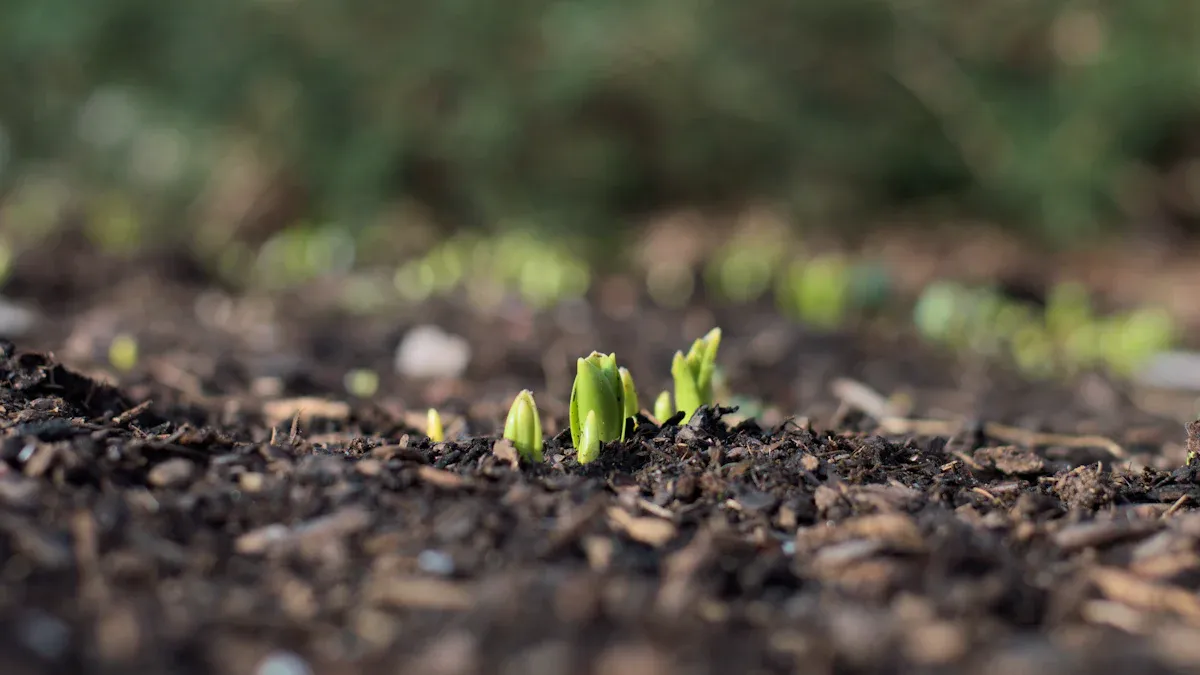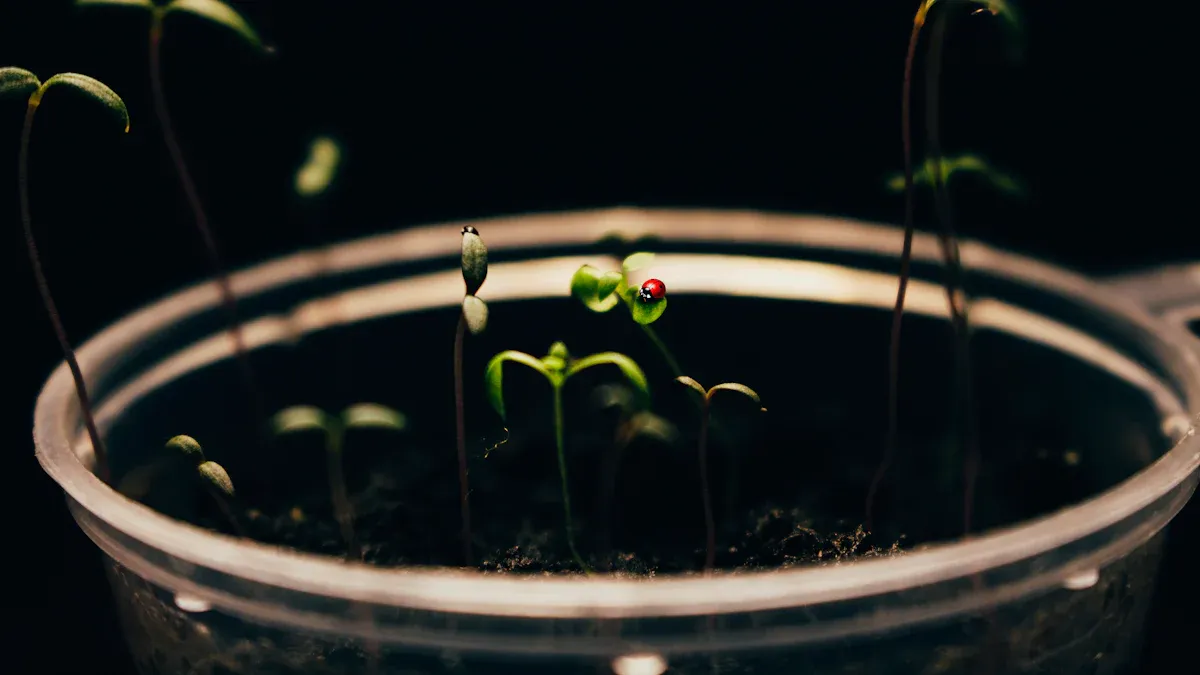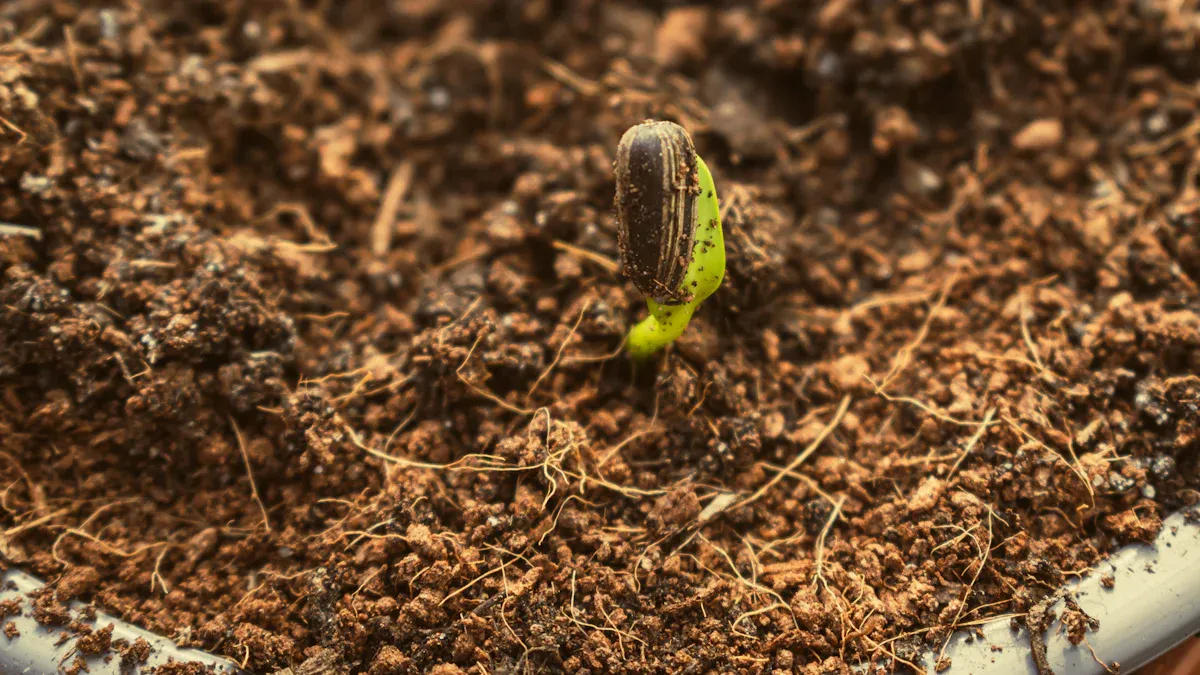
Quick seed germination is crucial for thriving gardens. As a gardener, you might struggle with issues like inadequate light, overwatering, or tricky seeds that refuse to sprout. Don’t worry! You can speed up seed germination by using some effective techniques that make all the difference. 🌱
Key Takeaways
Soak seeds before planting to soften their outer coats. This helps them absorb water quickly and improves germination rates.
Provide adequate light for your seeds. Use fluorescent or LED lights to ensure they receive the right spectrum for healthy growth.
Maintain optimal moisture levels. Keep the soil moist but not soggy to prevent seeds from drowning or drying out.
Soaking Seeds

Soaking seeds is one of the simplest and most effective ways to speed up seed germination. By soaking your seeds, you soften their hard outer coats, allowing moisture to penetrate and kickstart the germination process. This technique can significantly enhance your success rate, especially with seeds that have tough shells.
Benefits of Soaking
When you soak your seeds, you can enjoy several benefits:
Faster Germination: Soaking helps seeds absorb water quickly, which can lead to faster sprouting.
Improved Germination Rates: Many seeds show higher germination rates after soaking. For example, studies have shown that soaking Acacia seeds in tap water for 72 hours can improve germination, while hot water treatments can also enhance rates significantly.
Reduced Disease Risk: Soaking can help eliminate pathogens on the seed surface, giving your plants a healthier start.
Soaking Techniques
There are various methods to soak your seeds effectively. Here are some popular techniques:
Room Temperature Soaking: Place your seeds in a bowl of room temperature water for the recommended duration. This method works well for most seeds.
Hot Water Soaking: For seeds with particularly tough coats, you can soak them in hot water (around 80 °C or 176 °F) for about 10 minutes. This method can help break down the seed coat and speed up germination.
Overnight Soaking: Some seeds, like cucumbers, benefit from an overnight soak. This allows them to absorb enough moisture without risking damage.
Here’s a quick reference table for recommended soaking durations for different seed varieties:
Seed Variety | Recommended Soaking Duration |
|---|---|
Peas | 8 to 12 hours |
Beets | 8 to 12 hours |
Peppers | Soak before planting |
Tomatoes | Soak before planting |
Cucumbers | Overnight |
Beans | 2 to 10 hours |
Pumpkins | 8 to 12 hours |
Corn | 6 to 24 hours |
Sunflower shoots | 24 hours in two stages |
Canna lilies | 12 to 24 hours |
While soaking can be beneficial, it’s essential to avoid common mistakes. Here are a few pitfalls to watch out for:
Soaking seeds for too long can suffocate them. For instance, tomato and pepper seeds should only be soaked for about 6 hours.
Over-soaking can cause bean seeds to split, leading to nutrient loss and increased disease susceptibility.
Avoid using harmful soaking solutions like bleach. Instead, consider alternatives like chamomile tea or hydrogen peroxide for added benefits.
By following these soaking techniques, you can significantly speed up germination and give your seeds the best chance to thrive!
Light Requirements
Light plays a crucial role in seed germination. Without it, many seeds struggle to sprout. Research shows that light exposure is essential for the germination of seeds like Streptocarpus rexii. In fact, blue light is particularly important for developing macrocotyledons and establishing anisocotyly. This means that light isn’t just a nice-to-have; it actively influences the physiological processes that help seeds germinate.
Importance of Light
When seeds receive adequate light, they can produce vital compounds that promote germination. For instance, studies on lettuce seeds reveal that light encourages the production of nitric oxide and phospholipase D-derived phosphatidic acid. These compounds are key players in the biochemical pathways that facilitate germination. So, ensuring your seeds get the right light can make a big difference in their growth.
Best Light Sources
You have several options when it comes to providing light for your seeds. Here are some of the best sources:
Fluorescent high intensity (T5) bulbs: These bulbs offer high output efficiency and low heat, making them perfect for sun-loving plants.
Standard Fluorescent bulbs (T12): While they provide weaker intensity, they work well for plants with modest light needs.
LED lights: These are energy-efficient and have a long lifespan, though they may require a higher initial investment.
Most seedlings thrive under high-quality T8 fluorescent lights, which should be kept close to their tops. Aim for around 22 hours of light per day to meet their daily light integral (DLI) needs. Remember, plants primarily use blue and red light for growth. Blue light promotes vegetative growth, while red light aids in flowering. Combining both can significantly boost germination traits and seedling development.
Planting Depth
Planting depth is a key factor in seed germination. It can significantly influence how well your seeds sprout. If you plant seeds too deep, they might struggle to break through the soil. On the other hand, if they’re too shallow, they may dry out or get washed away.
Understanding Seed Size
Different seeds have different energy reserves. Small seeds, for example, have limited energy to push through the soil. This makes consistent planting depth crucial for them. If you don’t plant them deep enough, they may not have the strength to reach the surface. Larger seeds, however, are generally more forgiving. They can handle a bit of variation in depth without affecting their germination rates.
Guidelines for Depth
Here are some handy guidelines to help you determine the right planting depth for your seeds:
Most seeds should be sown at a depth equal to one seed diameter.
Tiny seeds should be sown on the surface of the soil.
Always check seed packet instructions for specific planting depths.
In dry conditions, aim for a seed depth of 1.5 to 2.0 inches or deeper. This ensures moisture availability for germination. Remember, soil texture matters too! Coarse-textured soils dry out faster than medium-textured soils. So, keep an eye on your seed placement and adjust as needed. If the soil is hard or dry, you might need to apply extra down-pressure to help your seeds get in the ground properly.
By following these guidelines, you can optimize your germination rates and give your seeds the best chance to thrive!
Temperature Control
Temperature plays a vital role in seed germination. If you want to speed up seed germination, keeping your seeds at the right temperature is essential. Most seeds thrive in temperatures between 65°F to 75°F (18°C to 24°C). However, some seeds, like tomatoes and peppers, have specific needs.
Ideal Temperature Ranges
Here are the ideal temperature ranges for popular garden seeds:
Tomatoes: Minimum soil temperature of 60°F (15.5°C) for planting.
Peppers: Optimal bottom heat between 80°F to 90°F (27°C to 32°C) for successful germination, taking about 7 to 8 days.
By maintaining these temperatures, you can enhance the germination rate and ensure your seeds sprout effectively.
Using Heat Mats
Heat mats are a fantastic tool for gardeners looking to achieve faster germination. They provide consistent warmth, which is crucial for seeds that require higher temperatures. Here’s why you should consider using them:
Heat mats create optimal soil temperatures that enhance the chemical reactions necessary for germination.
Seeds germinate faster and have a higher success rate when kept at their ideal temperature.
Warmer soil reduces the likelihood of diseases and promotes stronger root development.
If your ambient temperatures are below optimal, heat mats can be a game-changer. They’re especially beneficial for warmth-loving seeds like tomatoes and peppers. Just remember to monitor the soil temperature with a thermometer to ensure it stays within the ideal range. After germination, gradually lower the temperature to keep your seedlings healthy.
By controlling the temperature effectively, you can significantly speed up germination and give your seeds the best chance to thrive!
Moisture Management

Keeping your seeds moist is essential for successful germination. However, you need to strike a balance to avoid overwatering. Too much water can drown seeds, while too little can prevent them from sprouting. Here are some tips to help you manage moisture effectively:
Keeping Seeds Moist
Aim for Consistency: Keep the substrate moist but not soggy—think of a ‘wrung-out sponge.’ You can use dome lids to maintain humidity, but remember to remove them occasionally. This prevents condensation buildup and mold.
Prevent Drying Out: Ensure your substrate doesn’t dry out completely. Small seeds, in particular, need constant surface moisture to sprout. If they dry out, they may never germinate.
Use Quality Water: Hard water or water with high salinity can harm germination. Rainwater or filtered water is best, as it reduces the risk of salt buildup and pH imbalance.
Avoiding Overwatering
While moisture is crucial, overwatering can lead to problems like mold and algae growth. Here’s how to avoid it:
Manage Algae and Mold: A little algae isn’t harmful, but unchecked growth can compete with seedlings. If you see algae, reduce watering and increase airflow. Scrape off affected areas and consider adding a light sprinkle of vermiculite to suppress further growth.
Monitor Moisture Levels: Aim for around 20% moisture in your soil for optimal germination rates. Studies show that this level supports the highest germination rates and helps seedlings develop strong root systems.
By managing moisture carefully, you can significantly speed up seed germination and ensure your seedlings grow healthy and strong!
Germination Tips
When it comes to speeding up seed germination, pre-sprouting techniques can make a big difference. These methods help you prepare seeds for the germination process, giving them a better chance to sprout quickly and successfully. Here are some effective pre-sprouting techniques you can try:
Epsom Salt: Adding Epsom salt to your soaking water can enhance seed growth. The magnesium in Epsom salt strengthens cell walls, which helps seeds absorb water more effectively.
Nicking: This technique involves using a knife or sandpaper to gently scar the seed coating. By doing this, you allow moisture to penetrate the seed more easily, which can speed up germination.
Stratification: This method mimics winter conditions. By exposing seeds to cold temperatures, you can break dormancy and promote faster germination when spring arrives.
Pre-soaking: Soaking seeds in warm water is particularly effective for warm-weather crops like tomatoes and peppers. This helps them absorb moisture and kickstart the germination process.
Using these pre-sprouting techniques can significantly improve your chances of germination and help you germinate tricky seeds with ease.
Scarification and Stratification
Scarification is essential for seeds with hard outer coats. This process allows for gas exchange and water absorption by breaking the seed coat. Without scarification, seeds like Ebenopsis may struggle to germinate. Here’s a quick look at how scarification can improve germination rates:
Treatment Method | Species | Germination Rate (%) |
|---|---|---|
Acid scarification with H2SO4 (5 min) + Hot water (2 min at 100°C) | C. pseudo-olitorius | 90 |
Acid scarification with H2SO4 (10 min) + Hot water (2 min at 100°C) | C. aestuans | 92 |
Acid scarification with HCl (10 min) + Hot water (2 min at 100°C) | C. tridens | 84 |
Acid scarification with HCl (10 min) + Hot water (2 min at 100°C) | C. trilocularis | 71 |
Acid scarification with H2SO4 (30 min) | C. fascicularis | 56 |
As you can see, scarification can lead to impressive germination rates for hard-coated seeds.
Stratification, on the other hand, is a method that mimics natural winter conditions. This process is crucial for seeds that require cold treatment before germination. It ensures that seeds don’t sprout too early, improving their chances of successful germination when conditions are right.
By incorporating these germination tips into your gardening routine, you can significantly speed up seed germination and improve your chances of germination. Experiment with these techniques to see what works best for your seeds!
In summary, you can speed up seed germination using various methods. Consider soaking seeds, scarifying tough coats, and maintaining optimal temperature and moisture levels. Experiment with these techniques to discover what works best for your seeds. Remember, gardening is all about learning and adapting! 🌱
FAQ
What seeds benefit most from soaking?
Seeds with hard coats, like beans and peas, benefit greatly from soaking. It helps them absorb moisture and speeds up germination.
How long should I soak my seeds?
Soak seeds for 6 to 24 hours, depending on the type. Always check specific recommendations for each seed variety.
Can I use tap water for soaking seeds?
Yes, you can use tap water. However, filtered or rainwater is better to avoid chemicals that may affect germination. 🌧️

